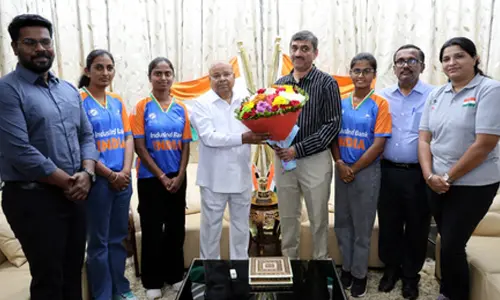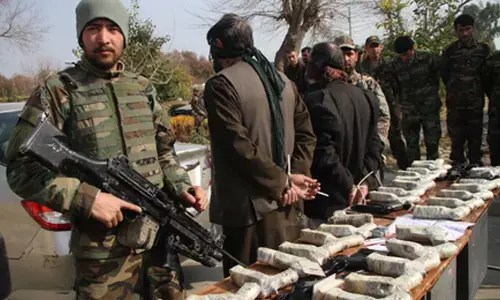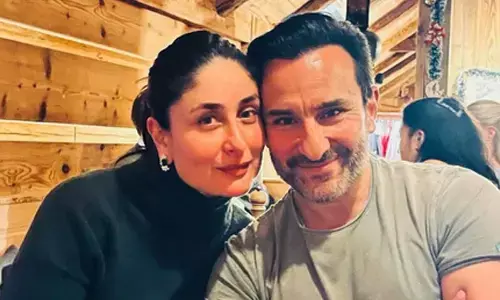Crisis in Higher Education – Ailments & Remedies

The managements are not paying the faculty and other staff salaries for the last ten months. Their repeated requests and representations have yielded no positive results so far.
The managements are not paying the faculty and other staff salaries for the last ten months. Their repeated requests and representations have yielded no positive results so far. The managements are postponing salary disbursement. Keeping the welfare of the students faculty are working in these colleges. Now all our financial resources have dried up. Relaxation of the student-teacher ratio by All India Council for Technical Education and falling admissions in engineering and Professional courses like MBA & MCA and Pharma courses have forced 28000 faculty members out of their jobs in 2018 & 2019 causing concern among educationists that it may further bring down the quality of technical education in Telangana. With admissions declining, unemployed engineering teachers with Post graduate degrees are finding it difficult to get new jobs. Some are forced to work for meagre salaries. Instead of sending the poor performers out, colleges laid off senior staff with higher pay to cut costs. During annual inspection, they hire faculty members temporarily and show them as Professors. For engineering colleges, a staff student ratio of 1:15 is ideal. It would not overburden the faculty and they can pay attention to all students and research project. Without consulting academics or educationists, AICTE has relaxed the rule.
Many faculty members said complaining to the AICTE was of no avail. Nearly 40 percent of the senior faculty members and high paid salaries are sacked without any prior notice in engineering colleges / Private deemed universities. Many colleges are in financial stress due to poor admissions. Assistant professors in most of the engineering colleges and Private deemed universities are engaging more than 6 subjects. Weekly workload is 28 hours for Assistant Professor.
Private Universities (Bennett University, Mahindra Ecole Centrale and OP Jindal University)
The ever-increasing demand for faculty in private, new-age universities has pushed the salary packages for senior faculty like vice-chancellors and deans past the Rs 1-crore mark.
Private universities are paying croreplus salaries to senior-most faculty members, at least five headhunters told ET. "A good faculty abroad (US, Singapore) gets high packages of around $250,000-350,000 per annum. Not many institutes can offer this kind of salary across the board. However, there are few institutes (in India) that are offering this at the very top," said Suchet Narain, senior client partner in Korn Ferry, which does senior-level searches in the education space.
Paucity of talent has prompted universities to now rope in headhunters to scout for academics. "The exponential growth of private universities & colleges has further compounded the problem with institutions vying for the same set of professionals available from an extremely limited pool," "In order to attract the talent, private universities and colleges are offering a slew of monetary & nonmonetary incentives such as shortterm foreign deputation under exchange programs, increased spend on training & development, extended research time-offs, variable pay, involvement with corporates, etc.," Very few universities in North India — nearly 20% of its 150-member faculty are foreign nationals — offers salaries competitive to universities in Europe, Australia and South Asia. "Professors in these countries draw a salary between $100,000 and $250,000 per annum. "Salaries have indeed increased over the last two years," he said. Academics at government universities and institutes say they would make the switch to private institutes for research opportunities, more grants and not just the money.
"Fed up with bureaucratic methods of functioning, many at government colleges leave soon. The attrition rates are very high at the government institutes,"
Above all, these universities get support for carrying out research. "Apart from a decent leave for research, they get funds too," . The promotions at government institutes take around 10 years. "But here an assistant professor becomes associate professor in four to six years,"
Deemed / Private Universities in AP / Telangana :
Higher education in the country, particularly engineering education, is facing a crisis. It is pulling on with half the teacher strength it requires. The government pressed a red button the other day when it was revealed in Parliament that the country faced a shortage of more than 4,00,000 teachers in its institutions of higher learning. In engineering education alone, the shortage is more than 2,10,000.
This finding revealed in the most recent government assessment of faculty shortage across the country has come as a shock. What is more shocking is the increase in the faculty shortage to 54 per cent from the 40 per cent a few years ago. The government has swung into action by allowing institutions to hire expatriate Indians to make up for the shortage. The Union Ministry of Human Resource Development has permitted the 15 Indian Institutes of Technology (IITs), premier engineering institutes in the country, to appoint non-resident Indians (NRIs) and people of Indian origin (PIOs) as permanent faculty as part of measures to tide over the teacher shortage. Foreign nationals, however, are not allowed permanent appointment.
But is this move a solution? Experts call it inadequate.
The Lok Sabha was told last week that 2,983 teachers were required immediately for the 25 IITs and 2,824 for the 42 National Institutes of Technology (NITs). But that is just the tip of the iceberg.
From 40 per cent to 50 per cent of the teaching posts are lying vacant in the country's top engineering institutions. The situation is worse in hundreds of private self-financing colleges.
A recent assessment made by an eight-member committee appointed by the Kerala government revealed that hardly one-fifth of the engineering institutions in the State met the stipulations made by the All India Council for Technical Education (AICTE). Of the 24 engineering colleges the committee inspected at random, only five were found to have met most requirements stipulated by the AICTE.
The AICTE currently stipulates a 1:15 teacher-student ratio for engineering institutions. "That itself is very high from a healthy academic perspective," said a senior professor of NIT, Calicut. Plans are afoot to bring down the teacher-student ratio in engineering institutions to 1:12. The ideal teacher-student ratio, expert say, is 1:10, which is the international standard.
The Central engineering institutions, including the NITs and the IITs, started facing the faculty shortage with a 27 per cent increase in number of seats for other backward classes (OBCs) over three years from 2016 to 2019. This increase resulted in a cumulative increase of 54 per cent in faculty requirement, which remains unfilled for various reasons.
The lack of recruitment of supporting or non-teaching staff in recent years has compounded the problem. The ratio of teaching and supporting staff is 1:1.1 in Central engineering institutions. When the student intake doubled in recent years with the increase in seats and courses, not a single appointment of supporting staff was made in the past nine years at NIT, Calicut. The result is that the faculty is being forced to spend part of their time for clerical work, leading to a dilution in academic activities. And the ultimate loser is the student.
The shortage of faculty affects the students in many ways. When there are not enough teachers, more students are often assigned to a single project, leading to a lack of attention from teachers and an eventual dilution in quality. Besides, the choices before the students for their elective subjects are considerably reduced.
T.K. Suresh Babu, Professor and Head of Training and Placement at NIT, Calicut, says recruiters from core engineering industry often give due weight to students who have done good projects for employment. The faculty shortage has a direct bearing on the quality of projects on all engineering college campuses.
The faculty shortage was felt more in the middle-level cadre. The AICTE stipulates a faculty cadre ratio of 1:2:4 for professors, associate professors, and assistant professors.
"There are no problems at the top-level posts of professors and principals as they get enough retired hands. The shortage at entry level too is not felt so keenly as in the middle level, where people well positioned in the industry cannot be attracted,".
Although the AICTE has made M.Tech. degree mandatory for faculty, most private engineering colleges are yet to abide by it. The AICTE has given two more years to the colleges, knowing full well that there are not enough hands with M.Tech to teach.
Of the 270 engineering colleges in Telangana, hardly one-eighth offer M.Tech programmes. In the wake of a new AICTE stipulation and an appeal by Union Human Resource Minister, many institutions came forward to start postgraduate programmes. But the State's universities have not been considerate. Several colleges were denied permission to do so.
The faculty shortage is the worst in the branches of computer science and electronics and communication in almost all engineering colleges. The reason is simple. The engineering graduates of these two branches are much sought after by the industry.
Unattractive pay is another reason for the dearth of faculty in engineering colleges. Although the AICTE has stipulated a pay scale, not all private engineering colleges in the country offer that pay to the faculty. "Only good pay can attract good people from the industry to teaching,"
When private engineering colleges, particularly those started in recent years, are worried about meeting the AICTE stipulations including the faculty strength, top institutions such as the IITs and the NITs are worried about the dwindling quality of their research.
"Right now, we don't have a mechanism to measure the quality. And that is where we survive,"
Dr. Srinivas, who is working at Purdue University, U.S., one of the top 20 technical institutions in the world, says that as a professor at the NIT, he gets three times the workload that he used to get at Purdue. "Shortage of hands leads to overloading of the faculty. When the faculty is overloaded, the students suffer at all levels. And research is the worst casualty," he adds.
It is this lack of quality at higher level academics, particularly doctoral and post-doctoral research, which deprives India of any single technical institution of international repute. "We have IITs. But they are known only for churning out the best undergraduates. Good institutions worldwide are measured in terms of research — in terms of the number of Nobel laureates they create and patents they win," Dr. Srinivas says.
Even when the country's education managers talk volumes about enhancing the quality, little is often done towards walking that talk. That was perhaps why the National Association of Software and Services Companies (NASSCOM) observed a couple of years ago that hardly 23 per cent of the students passing out the country's engineering institutions were employable.Accreditations/NIRF rankings void?
The accreditations by the National Board of Accreditation (NBA), National Assessment and Accreditation Council (NAAC) and National Institutional Ranking Framework (NIRF) are now allegedly nullified due to the implementation of the new SFR policy. "Very few top-ranking, self-financing institutes still retain their old staff strength. For other institutions, reduction in staff strength with AICTE's ruling is just like cutting a cake with a knife. So, all accreditations that had happened are not applicable for the new atmosphere,"
AICTE and Private College Managements / Trusts in Nexus ?
The AICTE continuously highlights closure or reduction in number of of colleges and seats, which is "intentionally" reducing the positive perception towards education. "Unfortunately, the AICTE supports such a move despite being a regulatory body,", "When there are plenty of available areas of improvement, AICTE projects only the closure of seats for the last complete month, hinting towards being in the hands of college-owning barons, who could twist the facts to aid their education-business".
It is learnt that the AICTE decided to reduce the faculty to help the institutions recover from financial burdens. It raises a big question as to whether the AICTE has monitored or cross-verified the institutions' bank statements along with the faculties' salary statements. The answer is negative. "It is clear that even after demonetisation and digital economy initiatives, the AICTE is not bothered about digitising the students' fees and staff salaries in the institutions. Issues are of meager importance that are being promoted by the AICTE and important issues are being summarily disregarded," .
In implementing new faculty student ratios, the AICTE – according to the petitioner – has broken the transparency that it followed all these years. The matter was allegedly not released in public domain prior to the decision. The decision was imposed over the society in an autocratic manner. "The AICTE had acted on the advice of associations of the managing trusts of colleges. Every trust is not a non-profitable service organisation, and largely are money-churning, family-owned organisations. Some AICTE officials have acted in nexus with these trusts, making a secret society, and the new faculty-student ratios are only a result of the meetings in these secret societies," During the academic year 2018-19, the total number of staff in all the approved institutions of AICTE was about 7,42,000 (as per the records of AICTE). It is further stated that for engineering & technology colleges alone, the number is a staggering 5,98,000. Even if the number is taken as an approximate of 5,00,000, the same accounts for 5,00,000 families with direct benefits from the employment in these private engineering colleges.
Private Engineering Colleges / Universities encourage Fake Doctorates
Faculty members who were blacklisted by the Jawaharlal Nehru Technological University, Hyderabad (JNTUH) in 2016 for holding fraudulent PhD degrees, seem to be back in business with several of them allegedly turning into research guides in private universities and autonomous colleges in both the Telugu States. They are now providing guidance for doctoral programmes as research supervisors in these institutions.
In 2016, JNTU-H had detected massive anomaly in the data uploaded by the faculty on its portal and over 900 faculty members with dubious records were caught and another eight were blacklisted due to the severity of the fraud they had committed.
According to JNTUH officials, despite being given the marching orders and being blacklisted, several of these members are now acting as postdoctoral guides to five to eight PhD scholars who are working under them for their PhD degrees in these institutions.
Though JNTU H registrar has refuted the allegations and claimed that "any faculty blacklisted by the varsity can't be taken on board by any other institution", faculty members in JNTUH affiliated colleges have alleged that the measures taken by the university were not tough enough to deter faculty members from furnishing faulty academic credentials or institutions from recruiting them.
"Since the fiasco, JNTUH released the list of faculty members with dubious credentials but nothing has deterred them and currently two of these members were listed as regular faculty working in a private university in the City. Even without having a PhD degree they are now acting as research supervisors," said an assistant professor from the University.
In addition, this particular university has retained names for three faculty members who are no longer working there. As a result, their names now appear on the list of faculty of two institutions — both former and current.
Duplication of faculty is also rampant. "To fool the system one faculty gets one identification number in their full name and in other, they use their abbreviated name. Some colleges list faculty who do not have PhDs or are pursuing the same from other institutions. This gets unnoticed because there is not enough inspection," said a faculty member from a JNTU affiliated college, in the city.
JNTUH, meanwhile, has instructed affiliated colleges to update any changes in the details, accreditation, autonomous status etc., regularly on their websites. It also warned that any discrepancy in this regard would call for disciplinary action against the erring colleges.
In a circular issued last December, it had warned that it had observed that "in certain affiliated colleges there was a mismatch in the faculty details between their websites and the data uploaded in UAAC portal. It is also observed that the faculty members who are blacklisted/disqualified/ resigned are still being shown in the respective websites."
Allegations are flowing thick and fast that a section of faculty members, who have been blacklisted by Jawaharlal Nehru Technological University- Hyderabad (JNTU-H), have turned into research guides in private universities and they are providing guidance for the doctoral programmes as research supervisors. According to the JNTU-H sources, the university had earlier blacklisted some faculty members on the ground that they had obtained fraudulent doctoral certificates. Action was taken against these members as per section 12.9 of the affiliation regulation of the university. That apart, the university also decided to initiate legal action against them in due course. The news that some of those, who were given marching orders, are now doing pretty good in some autonomous colleges and private universities in Telangana and Andhra Pradesh came as a rude shock
Some of them are acting as research supervisors and around five to eight research scholars are working under them for their doctoral degrees, the sources said. Speaking to The Hans India, a senior official from the university said, the university has adopted a tough posture to take on those providing false and misleading information to the university about their academic credentials, Giving reasons for the doubts emerging, another official said, of late the university is finding certain anomalies in the data of the faculty uploaded to the university portal. For example, doubts are voiced that one faculty member having two or three employment identification numbers. Under one-identification number they are mentioning their full name and in case another they only give an abbreviated name.
Faculty overburdened in most of the Private Universities: This not only results in overburdening a small group of teachers but also adversely affects the quality of academic research taken up by them, says a Human Resource Development Ministry report.
"A low student-teacher ratio indicates the burden on a single teacher of teaching multiple students as well as the lack of time that each student gets. Apart from this simplistic effect, in an institution of higher learning, a smaller number of overburdened teachers are also unable to pursue any research or encourage their students to do so.
"Consequently, the culture of questioning and reasoning cannot be inculcated as a part of higher education in most institutions," the Education Quality Upgradation and Inclusion Programme (EQUIP).
The faculty shortage has worsened over the time due to increasing enrolment rate of the students and low faculty recruitment in the higher education institutes.
Enlisting the reasons for low student-teacher ratios at the higher education level, the report has noted that apart from not filling up the sanctioned strength, most institutions hesitate in creating new faculty positions.
"In addition to the low number of sanctioned faculty positions, faculty vacancy even in sanctioned strength is an extremely serious problem. Due to various reasons such as a ban on recruitment, lack of funds, and the reluctance of states to bear the long-term salary burden, a large number of faculty positions are not filled. Attracting faculty is a big challenge for rural and backward areas because of the lack of infrastructural support and reluctance of teachers in moving to non-urban areas," it stated.
In June, the University Grants Commission had issued guidelines asking the government-operated higher education institutions to fill up 3 lakh vacancies within six months Union HRD Minister Ramesh Pokhriyal 'Nishank' has also been emphasising on filling up faculty positions on war footing in various meetings with the higher education institutions.
Already three months completed only 3% of the Higher Education Institutes have released notifications.
Dr M. Suresh Babu, State Convener, Praja Science Vedika, Hyderabad.














